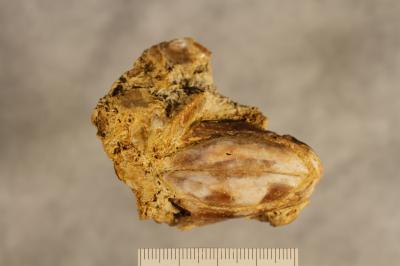Pieces of tiny fossil skull found in Fort Worth have been identified as 100 million-year-old coelacanth bones, according to paleontology graduate student John F. Graf of Southern Methodist University. That places it in the the Cretaceous geologic period, which extended from 146 million years ago to 66 million years ago.
Graf has named the new coelacanth species Reidus hilli and it is now the youngest coelacanth identified in Texas. The previous youngest was 200 million-years-old. Reidus hilli is named, in part, for the citizen scientist who discovered the fish, Robert R. Reid. At the time, SMU paleontologist Louis L. Jacobs recommended to Reid that he donate the fossil and have it scientifically identified. Reidus hilli is the latest of many fossils Reid has discovered and others also have been named for him. Graf also named the fossil for Robert T. Hill, a geologist with the U.S. Geological Survey who led surveys of Texas during the 1800s. Hill described much of the geology of Texas, including the Duck Creek Formation. Hill is acclaimed as the "Father of Texas Geology."

Reidus hilli is a new species of coelacanth fish, the youngest discovered in Texas. Image: Dale Winkler, SMU
"When I found it, I could tell it was a bone but I didn't think it was anything special," said Reid, recalling the discovery. "I certainly didn't think it was a coelacanth."
Reidus hilli came from the fossil-rich Duck Creek Formation, which is a layer-cake band of limestone and shale about 40 feet thick. The fossil was found in marine sediments and is one of many marine fossils found in the North Texas area, which 100 million years ago was covered by the Western Interior Seaway that divided North America from the Gulf of Mexico to the Arctic Ocean.
The coelacanth was thought to have gone extinct about 70 million years ago. That changed, however, when the fish rose to fame in 1938 after live specimens were caught off the coast of Africa. Today coelacanths can be found swimming in the depths of the Indian Ocean. Coelacanth fossils have been found on every continent except Antarctica, so it has eluded extinction for 400 million years. Scientists estimate the coelacanth reached its maximum diversity during the Triassic. They share the most recent common ancestor with all of terrestrial vertebrates.
Coelacanths have boney support in their fins, which is the predecessor to true limbs. "Boney support in the fins allows a marine vertebrate to lift itself upright off the sea floor," Graf said, "which would eventually lead to animals being able to come up on land."
He identified Reidus hilli from a partial skull, including gular plates, which are bones that line the underside of the jaw. "Coelacanths are not the only fish that have gular plates, but they are one of the few that do. In fact, the lenticular shape of these gular plates is unique to coelacanths. That was the first indicator that we had a fossil coelacanth."
Reidus hilli was an adult fish of average size for the time in which it lived. While modern coelacanths can grow as large as 3 meters, Reidus hilli was probably no longer than 40 centimeters. Its tiny skull is 45 millimeters long by 26 millimeters wide, or about 1.75 inches long by 1 inch wide. Reidus hilli's total body size is typical of the new family of coelacanths, Dipluridae, which Graf described and named. He chose the name for the least primitive coelacanth in the family, Diplurus, which lived during the Triassic.
Diplurid coelacanths are typically smaller than the two families with which they are most closely associated, Mawsoniidae and Latimeriidae. Mawsoniidae and Latimeriidae both have late Cretaceous members reaching large body sizes, ranging from 1 meter to 3 meters in total body length.
Published in Historical Biology: An International Journal of Paleobiology





Comments